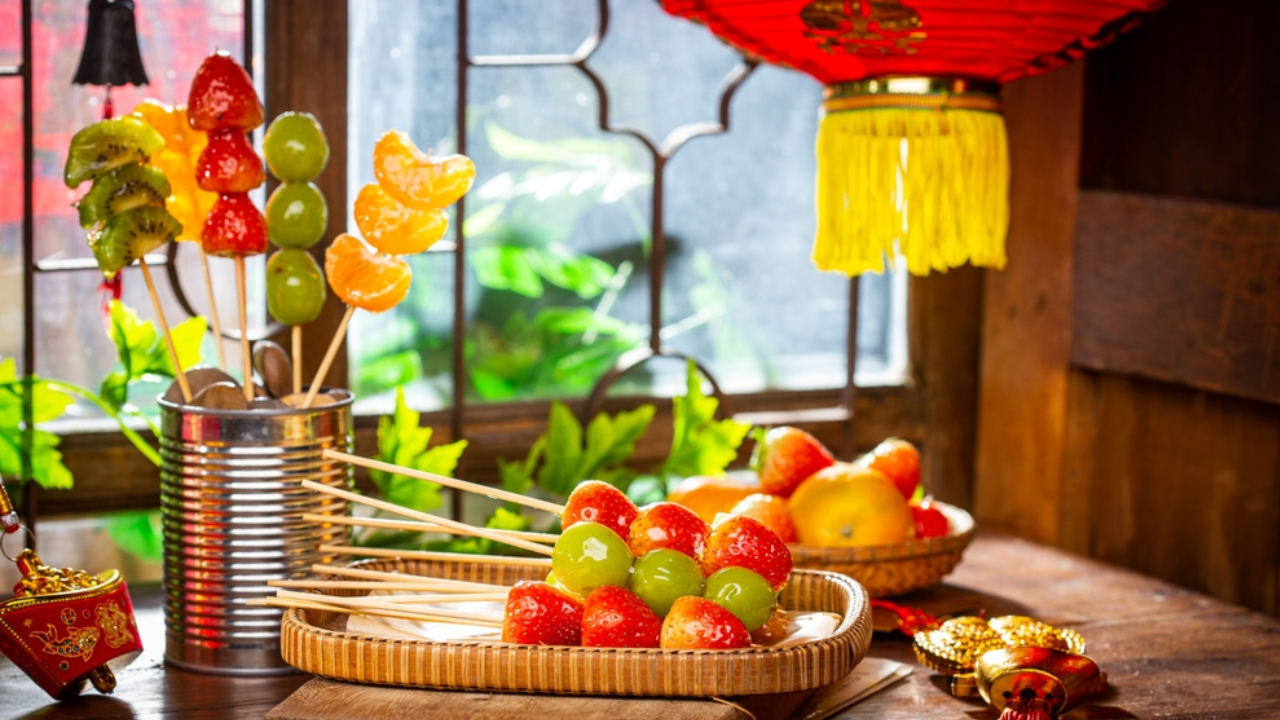
Send Your Article To : SEND NOW

If you’ve ever come across mesmerizing ASMR videos of people biting into glossy, crunchy skewers of candied fruit, chances are you’ve encountered tanghulu. This iconic Chinese street food is more than just a visual delight—it’s a crunchy, juicy, and sweet treat that’s loved by many worldwide. Whether you’re craving something unique or want to try a fun recipe at home, this guide will teach you how to make tanghulu and explore its history, variations, and tips for success.
What is Tanghulu?
Tanghulu is a traditional Chinese snack made of fruit skewers coated in a hard candy shell. Originally, this treat featured hawthorn berries, but today, it’s commonly made with fruits like strawberries, grapes, kiwi, and mandarin slices.
This sweet snack is popular not only in China but also across Asia, often sold as street food. Its appeal lies in the satisfying crunch of the candy shell, which gives way to the juicy, tangy flavor of the fruit inside. Whether it’s your first time making it or you’re a tanghulu enthusiast, this recipe is guaranteed to impress!
History of Tanghulu
Tanghulu has its roots in northern China during the Song Dynasty. Legend has it that a concubine of the emperor fell ill, and no medicine could cure her. A skilled doctor prescribed a remedy of hawthorn berries simmered in sugar syrup, which miraculously restored her health. Over time, this candied fruit became a popular snack, evolving into the crunchy and colorful treat we know today.
Recently, tanghulu has gained international fame, thanks to platforms like TikTok. Videos showcasing the glossy candy coating and the satisfying crunch have made this traditional snack a modern-day internet sensation.
How to Make Tanghulu?
Making tanghulu at home is surprisingly simple and requires just a few ingredients. Here’s the step-by-step guide to perfecting this delightful treat.
Ingredients You’ll Need
- Fresh fruits (strawberries, grapes, kiwi, mandarin slices, or even crab apples)
- 2 cups of granulated sugar
- 1 cup of water
- Wooden skewers
Directions
- Prepare the Fruits
Wash and dry the fruits thoroughly. Any moisture will prevent the candy coating from sticking. Remove stems if necessary and ensure the fruit is dry before proceeding. - Skewer the Fruits
Thread your chosen fruits onto wooden skewers. You can mix and match fruits like strawberries and grapes or stick to one type per skewer. - Make the Syrup
Combine sugar and water in a heavy-bottomed saucepan. Heat the mixture over medium heat without stirring until it reaches 300°F to 310°F, also known as the hard-crack stage. - Dip the Fruits
Quickly dip each skewer into the syrup, ensuring the fruit is fully coated. Lay the coated skewers on a parchment-lined baking sheet to cool. Within a few minutes, the syrup will harden into a shiny, crunchy shell.
Pro Tips for the Perfect Tanghulu Recipe
- Always use a candy thermometer to monitor the syrup’s temperature.
- Avoid spooning the syrup onto the fruit, as it can create bubbles and lead to a cloudy finish.
- Work quickly, as the syrup cools and hardens fast.
Why is Tanghulu Sticky Instead of Crunchy?
If your tanghulu turns out sticky or chewy, it’s likely because the syrup didn’t reach the hard-crack stage. The proper temperature ensures the candy shell is crisp and doesn’t stick to your teeth. Reheat the syrup if needed, and monitor it closely with a thermometer to achieve the perfect texture.
Fruits to Use for Tanghulu
One of the best parts of making tanghulu is experimenting with different fruits. While the classic version features hawthorn berries, here are some popular options:
- Strawberries
- Grapes
- Kiwi
- Mandarin slices
- Crab apples
Feel free to get creative with your combinations!
Why You Should Try Tanghulu?
Whether you’re looking to satisfy your sweet tooth or impress guests with a unique snack, tanghulu is the perfect choice. The combination of a crunchy candy shell and fresh, juicy fruit creates a contrast of textures and flavors that’s hard to resist. Plus, it’s a fun and interactive recipe to try with friends or family.
Conclusion
Now that you know how to make tanghulu, it’s time to gather your ingredients and try this simple yet delightful recipe. From its historic roots in China to its viral fame on social media, tanghulu continues to capture hearts (and taste buds) worldwide. Don’t forget to experiment with different fruits and share your creations—because nothing beats the joy of crunching into a perfectly made tanghulu skewer!
By following this guide, you’ll not only master the art of making tanghulu but also enjoy a piece of history with every bite.
Recent Posts
- Epimedyumlu Macun in UAE: Benefits, Availability & Price Guide
- What is MGO in Manuka Honey? - Manuka Honey MGO chart
- Logan Paul vs Mayweather: The Boxing Showdown Between the Celebs
- Ash Trevino : Controversial TikTok Star's Controversy and More
- How Image Format Impacts Website Load Speed and Ranking
- Unlocking the Power of Janitor AI : Revolutionizing Workflow Automation
- NSA Warning Update: How to Protect Your Messaging Apps from Cyber Threats
- Bedroom Modern Pop Plus Minus Design: The Ultimate Guide to Contemporary Elegance
